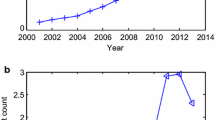Abstract
The technological progress makes great contribution to the rapid economic growth of China during its past three decades of reform and opening up. An empirical analysis conducted over China’s total factor productivity certifies this conclusion but it also reveals that China’s TFP growth rate is not very high. We further explore the various stages of change of China’s total factor productivity and the causes of these changes and finally take an analytical calculation over the present flaws of China’s innovation system and offer some advices.





Similar content being viewed by others
Notes
South Africa, 50; Brazil, 53; India, 56; Russia, 66; furthermore, China's position descends to the 29th in the next year (Schwab 2012).
Primary reason for setting 1981 as the starting year is because investment data are available since 1981 in National Bureau of Statistics (2010), and China’s reform and opening up policy was adopted at the end of 1970s.
Our calculation reveals that the TFP growth rate was lower than GDP growth rate by a 4.8 % in the first two stages and by 5.7 % in the third stage.
The statistical data indicate the following: (1) Both the pace and scale of FDI's inflow into China were accelerated since China's entry into WTO. During the decade from 2001 to 2011, altogether 347,000 foreign funded corporations were established in China, with an accumulated influx of FDI of over $750 billion, heading the list of major developing countries of the world that absorb large quantities of FDI. (2) The data of its trade reflect a similar trend. The share of its overall volume of import & export to the world total had been uplifted from a mere 0.79 % in 1979 to 3.6 % in 2000, right before its entry into WTO, spending a 22 years. However, within only 10 years following its entry into WTO, its share of foreign trade to the world total was increased to 9.71 % in 2010, reaching the level of $29.73 billion, 6.3 times as much as its level of 2000. In 2010, China became the largest exporter of the world.
During 1999–2008, China's nominal GDP increased at an annual growth rate of 14.7 %, while the growth of its investment was at a rate of 21.5 %. This means that its investment played a more apparent and significant role in its economic development.
Typical opinions: Lin and Ren (2007).
Source of data: the Web site of the Central Government of P. R. China, http://www.gov.cn.
Luo and Yang (2008).
The indicator’s value of Tibet may be misleading. Province’s intensity of Corporate R&D expenditure can be regarded as the average value of all corporate intensity in the province. According to the National Bureau of Statistics, in 2009, there were only 90 industrial enterprises above designated size in Tibet, the total industrial output value was also very low, only 5.16 billion RMB. So, we can suppose that the indicator’s value may be affected by a large investment in one enterprise.
The Web site of China's National Statistical Bureau, http://www.stat.gov.cn.
Zhang (2011).
References
Bhagwati J (1996) The miracle that did happen: understanding East Asia in comparative perspective, keynote speech delivered at Cornell University on the occasion of conference on government and market: the relevance of the Taiwanese performance to development theory and policy in honor of professor Liu and Tsiang
Chen EKY (1997) The total factor productivity debate: determinants of economic growth in east Asia. Asia Pac Econ Lit 11 (1): 18—38, 54—70
Felipe J (1997) Total factor productivity growth in East Asia: a critical survey, economics and development center report series No. 65, Asian Development Bank, Manina
Li J, Meng L, Wu F (2006) Reexamination over China’s geographical gaps in development: factor accumulation or TFP. World Econ 1
Lin Y, Ren R (2007) East Asian miracle debate revisited. Econ Res J 8
Liu X, Chen A (eds) (2012) Annual report of regional innovation capability of China 2011: a study on regional innovation and strategic emerging industry. The Science Press, Beijing
Luo Z, Yang Z (2008) Evaluation of region innovation. Economic Science Press, Beijing
National Bureau of Statistics (2010) China compendium of statistics 1949–2008
Peng G (2009) Total factor productivity and regional disparity in China. Economic Science Press, Beijing
Schwab K (ed) (2011) The global competitiveness report 2011–2012. World Economic Forum. Available at www.weforum.org/gcr
Schwab K (ed) (2012) The global competitiveness report 2012–2013, World Economic Forum. Available at www.weforum.org/gcr
Song W, Li J (2006) Analysis of selected objectives of the contribution rates of China’s scientific and technological progress during the tenth five-year, forum on science and technology in China 6
Yin X (2009) The growth rate of China’s total factor productivity and its deconstruction: an empirical study based on the model of definitive frontier production. Inform Syst Eng 9
Zhang J (2005) An empirical research on capital formation, efficiency of investment and China’s economic growth. Tsinghua University Press, Beijing
Zhang M (2011) China’s brain drain ranking the global 1st: the China-US game behind China’s tide of immigration, Chinese economic weekly on the people’s daily, Available at http://finance.people.com.cn/GB/16248041.html
Zhao Z, Yang C (2011) Estimation and explanation of China’s total factor productivity: 1979–2009. Res Financ Econ 9:2011
Acknowledgments
The authors sincerely thank anonymous reviewer for his/her advices. Of course the authors are responsible for all the possible flaws of this paper.
Author information
Authors and Affiliations
Corresponding author
Rights and permissions
About this article
Cite this article
Ding, C., Li, J. Analysis over factors of innovation in China’s fast economic growth since its beginning of reform and opening up. AI & Soc 29, 377–386 (2014). https://doi.org/10.1007/s00146-013-0465-z
Received:
Accepted:
Published:
Issue Date:
DOI: https://doi.org/10.1007/s00146-013-0465-z




